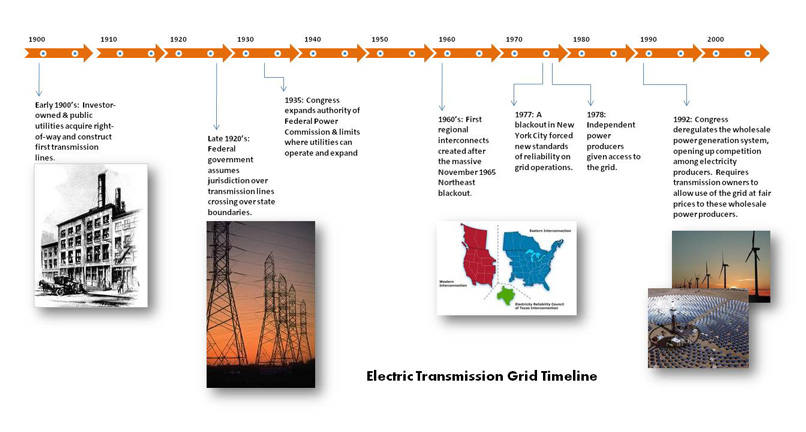The growth of these larger electric companies resulted in state governments extending the jurisdiction of their regulatory powers to include electric utilities. New York and Wisconsin were the first states to initiate regulatory commissions in 1907; and by 1914, 43 states had commissions in place for the regulation of electric utilities. In 1932, about three-quarters of the investor-owned utility businesses were controlled by eight holding companies, many of which crossed state lines.
Transmissions Grid Timeline

Click link to expand for a text description of Figure.5.3
Early 1900's: Investor owned and public utilities acquire right-of-way and construct first transmission lines.
Late 1920's: Federal government assumes jurisdiction over transmission lines crossing over state boundaries.
1935: Congress expands the authority of Federal Power Commission and limits where utilities can operate and expand.
1960's: First regional interconnects created after the massive November 1965 Northeast blackout.
1977: A blackout in New York City forced new standards of reliability on grid operations.
1978: Independent power producers given access to the grid
1992: Congress deregulates the wholesale power generation system, opening up competition among electricity producers. Requires transmission owners to allow use of the grid at fair prices to these wholesale power producers.
In 1927, as a consequence of this growth and consolidation, the U.S. Supreme Court ruled that electricity was not an intrastate commodity, but rather an interstate commodity subject to federal regulation. The Public Utility Holding Company Act (PUHCA) of 1935, was signed into law by President Roosevelt as a result of a Supreme Court ruling. PUHCA limits the geographical scope of utility holding companies and the corporate structure of the holding companies. The act vertically integrated utilities (allowing ownership of both generating facilities and transmission lines) in monopoly service areas. States retained jurisdiction over siting of generating facilities, transmission systems, and distribution rates.
With the backdrop of higher oil prices and a real concern about energy imports from politically unstable countries, Congress enacted the 1978 Public Utility Regulatory Policies Act (PURPA). PURPA was a game-changing piece of legislation because it required utilities to buy electricity from companies that were not designated as utilities, and created a new industry for independent power producers. This legislation also gave these independent power producers access to the transmission system they needed to deliver their power to the grid.
Again, because of the concern over the country’s dependence on foreign oil, Congress passed the Energy Policy Act of 1992 (EPACT). This Act allowed access to the grid by non-utility companies on rates and terms that were comparable to those that the utility would charge itself for access to the grid. Why was this important? Because it fueled the growth of the wholesale power market by allowing electric utilities and other power generators to use the transmission grid to send power to one another at fair market rates.
